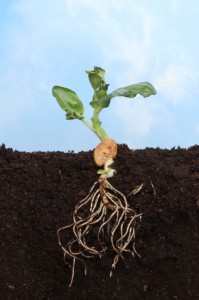Soil, an Exceptional Carbon Storage System
The Importance of Soil
Climate change in the news is becoming a daily occurrence. What to do with carbon pollution is at the heart of many of these articles. One novel approach hasn’t received much attention and it’s in our own backyard, soil. 
Soil is known to be highly effective at storing carbon. In fact, according to the group, The Carbon Underground, the Earth has been storing carbon in its soils for millions of years. They point out that just the first meter of soil contains 3 times as much carbon as there is in the atmosphere. If we could restore more carbon to the world’s soil, (it’s lost 50% to 80% since cultivation began), we could put a huge dent in the carbon pollution problem and climate change.
Carbon Agriculture
The Carbon Underground, in an article on www.fastcoexist.com, is suggesting a change from traditional farming methods to “carbon agriculture.” Current farming practices require a lot of plowing, causing erosion, which causes soil to flow into waterways or to blow away. Carbon agriculture promotes no till farming. It also promotes “holistic management”, a grazing technique popularized by biologist Allan Savory. (Savory’s TED talk has been viewed 3.2 million times).
Restoring Grasslands
The Carbon Underground is calling for policies that reinvigorate the 3.5 billion acres of grasslands in the world, many of which have degraded. “The largest immediate available opportunity to put carbon back into the ground is focusing on the huge quantity of grasslands where we can restore photosynthetic activity to put carbon back into the soil”, says Tom Newmark, co-founder of the group.
Grazing Technique
Peter Byck, editor and writer, known for the documentary, Carbon Nation, promotes a grazing technique in one of his films, which restores carbon to soil. By grazing animals for short intensive periods, grasslands maintain a diversity of plants, plants retain more water and farmers regenerate their soils. Ultimately, that helps the plants take in C02 and send carbon down to their roots, into microbes into the soil.
According to Larry Kopald, another co-founder of The Carbon Underground, there is a strong pent-up demand among farmers to move away from practices based around intensive tillage and heavy inputs, but not necessarily the money and resources. “If we took the subsidies that go to fossil fuels today and put that into the restoration of soil, we would deal with climate change within a generation,” he says.


